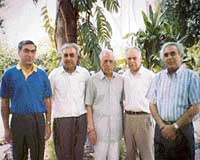Success is in their blood
|
|
This is a story that has its origins in Dingah village of Gujarat district in Pakistan, when 18-year-old Hira Lal Sibal married 14-year-old Kailash Rani of Bhimbar which is now a part of PoK. Mr Sibal went on to practice in the Punjab High Court in Lahore where his five children were born. Partition forced them out of their home in Lahore. Mr Sibal is nostalgic when he says, “We shifted from Lahore to Jalandhar, hoping that we would be able to return to our home after conditions improved. But that was not to be, so we moved to Shimla, and then when the Punjab and Haryana High Court shifted to Chandigarh in 1955, we did too”.
Sibal’s reputation as an advocate specialising in civil, criminal and election law is well-founded. He has been Advocate-General four times and was elected as the first non-official president of the Chandigarh Club, Rotary Club. He has been president of the High Court Bar Association twice.
Mr Sibal’s eldest son, V.K. Sibal, qualified for the IAS and opted for a UN deputation with the FAO. He is presently a judge with the Punjab Human Rights Commission. J.K. Sibal also qualified for the IAS and was assigned the MP cadre. After 18 years, he quit to return to legal practice in Chandigarh and is presently an advocate of repute.
Kanwal Sibal qualified for the IFS and rose to become India’s Foreign Secretary. He has recently been appointed Ambassador to Russia. The youngest Kapil Sibal also qualified for the IAS but chose the legal profession and went on to become a reputed Supreme Court advocate before he joined the Congress and is now a minister. Mr Sibal’s only daughter Asha is married to the former MD of Metalbox and former Chairman of BATA.
Mr Sibal’s wife, Kailash Rani, keeps a beautiful home and garden in Sector 5, Chandigarh. She has a photographic memory and follows a disciplined schedule, “Discipline is the quality I passed on to my children”, she says. Excerpts from an interview given to Bilawal and Punam Khaira Sidhu:
You must be a very proud father. What inspired your children to join the civil services ?
V.K. Sibal qualified for the IAS and set the trend for the others. I am indeed very proud of all of them as they are all good humans.
Were all of your son’s good at studies and academically inclined at an early age?
Yes, they all excelled in academics. I rarely had to tell them to study. They were all very motivated youngsters, who I knew would succeed in whatever they chose to do.
What schools did they go to?
They have studied at various schools and colleges in Shimla, Chandigarh and Ludhiana as we shifted from Shimla to Chandigarh. The youngest, Kapil, studied in St Johns and then moved on to St Stephens College in Delhi.
What were your sons interests/hobbies?
V.K. was an avid reader. There is hardly a book or an author he has not read. J.K. and Kanwal excelled in debates etc while Kapil was an all-rounder excelling in sports, dramatics and a cinema enthusiast.
Was there a lot of sibling rivalry?
Yes, but it was healthy and that is why each has tried to set the bar.
What are the qualities you ascribe to their success?
My wife and I tried to imbibe the qualities of discipline, honesty and perseverence in all of them.
How much has Chandigarh changed since you first moved here?
The changes have been dramatic. Chandigarh was a city of barely one lakh population and today it is over 10 lakh. It is dirty, polluted and crowded. The civic infrastructure and law and order set-up is under tremendous pressure.
What improvements would you like to see in the city?
Planned development of the periphery and satellite cities of Mohali and Panchkula can ease the pressure on Chandigarh. Each resident also needs to be aware of his civic responsibility to keep the city beautiful.
What is your message for the youth?
Work with sincerity and honesty to achieve your goals. Let it be like an obsession and you will achieve great results. As for the rest, destiny also determines your fate.

 A
A




 T
T
